
Concept explainers
Give the structure corresponding to each name.
a.
b.
c.
d.
e.
f.
g.
h.
(a)
Interpretation: The structure corresponding to
Concept introduction: The systematic naming of organic compound is given by IUPAC. The naming of organic compound is done such that the structure of organic compound is correctly interpreted from the name.
Rules for writing structural formula from IUPAC are:
• First identify the word root for the given compound.
• The suffix used in the compound like –ene.
• Identify the position, location, and number of the substituent bonded to the carbon chain.
Answer to Problem 21.44P
The structure corresponding to

Figure 1
Explanation of Solution
The given name is
The structure corresponding to
(b)
Interpretation: The structure corresponding to
Concept introduction: The systematic naming of organic compound is given by IUPAC. The naming of organic compound is done such that the structure of organic compound is correctly interpreted from the name.
Rules for writing structural formula from IUPAC are:
• First identify the word root for the given compound.
• The suffix used in the compound like –ene.
• Identify the position, location, and number of the substituent bonded to the carbon chain.
Answer to Problem 21.44P
The structure corresponding to
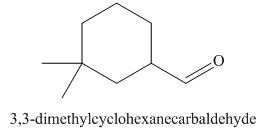
Figure 2
Explanation of Solution
The given name is
The structure corresponding to
(c)
Interpretation: The structure corresponding to
Concept introduction: The systematic naming of organic compound is given by IUPAC. The naming of organic compound is done such that the structure of organic compound is correctly interpreted from the name.
Rules for writing structural formula from IUPAC are:
• First identify the word root for the given compound.
• The suffix used in the compound like –ene.
• Identify the position, location, and number of the substituent bonded to the carbon chain.
Answer to Problem 21.44P
The structure corresponding to
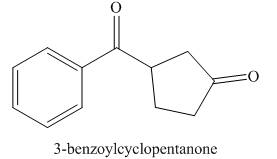
Figure 3
Explanation of Solution
The given name is
The structure corresponding to
(d)
Interpretation: The structure corresponding to
Concept introduction: The systematic naming of organic compound is given by IUPAC. The naming of organic compound is done such that the structure of organic compound is correctly interpreted from the name.
Rules for writing structural formula from IUPAC are:
• First identify the word root for the given compound.
• The suffix used in the compound like –ene.
• Identify the position, location, and number of the substituent bonded to the carbon chain.
Answer to Problem 21.44P
The structure corresponding to
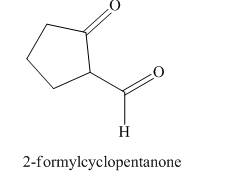
Figure 4
Explanation of Solution
The given name is
The structure corresponding to
(e)
Interpretation: The structure corresponding to
Concept introduction: The systematic naming of organic compound is given by IUPAC. The naming of organic compound is done such that the structure of organic compound is correctly interpreted from the name.
Rules for writing structural formula from IUPAC are:
• First identify the word root for the given compound.
• The suffix used in the compound like –ene.
• Identify the position, location, and number of the substituent bonded to the carbon chain.
Answer to Problem 21.44P
The structure corresponding to

Figure 5
Explanation of Solution
The given name is
The structure corresponding to
(f)
Interpretation: The structure corresponding to
Concept introduction: The systematic naming of organic compound is given by IUPAC. The naming of organic compound is done such that the structure of organic compound is correctly interpreted from the name.
Rules for writing structural formula from IUPAC are:
• First identify the word root for the given compound.
• The suffix used in the compound like –ene.
• Identify the position, location, and number of the substituent bonded to the carbon chain.
Answer to Problem 21.44P
The structure corresponding to
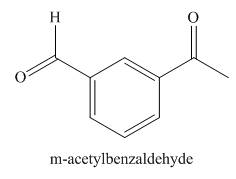
Figure 6
Explanation of Solution
The given name is
The structure corresponding to
(g)
Interpretation: The structure corresponding to
Concept introduction: The systematic naming of organic compound is given by IUPAC. The naming of organic compound is done such that the structure of organic compound is correctly interpreted from the name.
Rules for writing structural formula from IUPAC are:
• First identify the word root for the given compound.
• The suffix used in the compound like –ene.
• Identify the position, location, and number of the substituent bonded to the carbon chain.
Answer to Problem 21.44P
The structure corresponding to
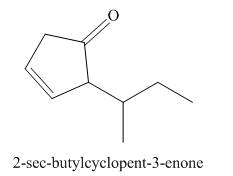
Figure 7
Explanation of Solution
The given name is
In the given compound, one benzaldehyde group is present. The functional group present in the given compound is ketone.
The structure corresponding to
(h)
Interpretation: The structure corresponding to
Concept introduction: The systematic naming of organic compound is given by IUPAC. The naming of organic compound is done such that the structure of organic compound is correctly interpreted from the name.
Rules for writing structural formula from IUPAC are:
• First identify the word root for the given compound.
• The suffix used in the compound like –ene.
• Identify the position, location, and number of the substituent bonded to the carbon chain.
Answer to Problem 21.44P
The structure corresponding to
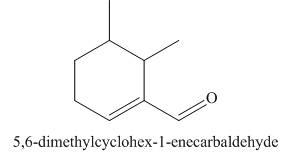
Figure 8
Explanation of Solution
The given name is
The structure corresponding to
Want to see more full solutions like this?
Chapter 21 Solutions
Organic Chemistry
- Draw the products formed when D-altrose is treated with each reagent. a. (CH3)2CHOH, HCl b. NaBH4, CH3OH c. Br2, H2O d. HNO3, H2O e. [1] NH2OH; [2] (CH3CO)2O, NaOCOCH3; [3] NaOCH3 f. [1] NaCN, HCl; [2] H2, Pd-BaSO4; [3] H3O+ g. CH3I, Ag2O h. C6H5CH2NH2, mild H+arrow_forwardWhich of the following will not oxidize benzaldehyde? -- acidified KMnO4 -- acidified K2CrO4 -- Tollen’s reagent followed by H3O+ -- Basic I2 in KIarrow_forwardGive the missing reagentsarrow_forward
- Match the ff reagents: a. Br₂ in CH₂Cl₂ b.CrO₃ , H₂SO₄, acetone c. concentrated HCl with ZnCl₂ d. aqueous FeCl₃ e. aqueous NaHCO₃ f. ammoniacal AgNO₃ 1. 4-bromophenol from benzene 2. hexane from 1-hexene 3. 1-hexanol from hexanal 4. hexane from hexanoic acid 5. 2-hexanol from 2-methyl-2-hexanol 6. 1-hexene from 1-hexynearrow_forwardDraw the product formed when (CH3)2CHOH is treated with each reagent. a.SOCl2, pyridine b. TsCl, pyridine c.H2SO4 d.HBr e.PBr3, then NaCN f.POCl3, pyridinearrow_forwardDraw the product formed when (CH3)2CHOH is treated with each reagent. a. SOCl2, pyridine b. TsCl, pyridine c. H2SO4 d. HBr e. PBr3, then NaCN f. POCl3, pyridinearrow_forward
- How could you use ethylbenzene to prepare each compound? More than one step is required.arrow_forwardDraw the organic products formed when allylic alcohol A is treated with each reagent.a.H2 + Pd-C b.mCPBA c. PCC d.CrO3, H2SO4, H2O e.(CH3)3COOH, Ti[OCH(CH3)2]4, (+)-DET f. (CH3)3COOH, Ti[OCH(CH3)2]4, (−)-DET g. [1] PBr3; [2] LiAlH4; [3] H2O h.HCrO4−–Amberlyst A-26 resinarrow_forwardI need help with part K. Which was the formula of the acetal product?arrow_forward
- Which will complete the following reactions? Choices: A. HBr / ether B. PBr3 / ether C. SOCl2 / pyridine D. Br2 / NBS E. Chlorocyclopentane F. Cyclopentanol G. Iodobenzenearrow_forwardDraw the major organic product or give the reagents needed to complete each.arrow_forwardPlease help with the reagents. thxarrow_forward
 Organic Chemistry: A Guided InquiryChemistryISBN:9780618974122Author:Andrei StraumanisPublisher:Cengage Learning
Organic Chemistry: A Guided InquiryChemistryISBN:9780618974122Author:Andrei StraumanisPublisher:Cengage Learning
